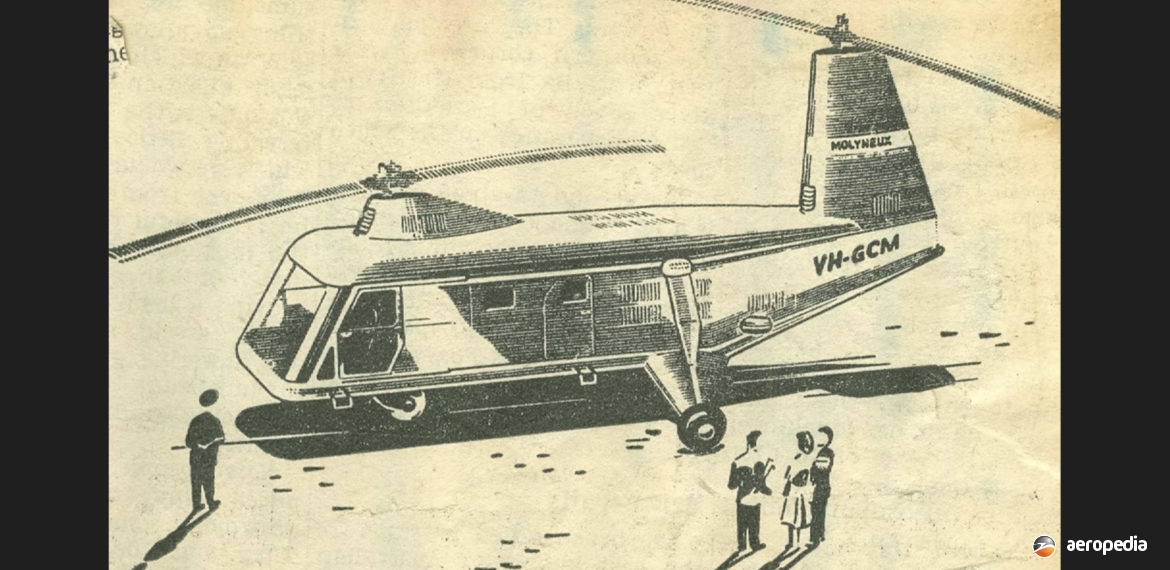Photograph:
Company drawing of the proposed helicopter with the registration VH-GCM (Molyneux – Author’s collection)
Country of origin:
Australia
Description:
Twin-rotor utility helicopter
Power Plant:
One 410 kw (550 hp) Pratt & Whitney R-1340 nine-cylinder air-cooled radial engine
Specifications:
- Rotor diameter [each]: 9.14 m (30 ft)
- Max speed: 177 km/h (110 mph)
- Hovering ceiling: 1,829 m (6,000 ft)
- Range: 563 km (350 miles)
- Ceiling: 4,572 m (15,000 ft)
- Cruising speed: 145 km/h (90 mph)
- Rate of climb: 296 m/min (971 ft/min)
- Loaded weight: 1,814 kg (4,000 lb)
History:
Grevor Chilton [known as Bing or George] Molyneux, who was born in 1917 and passed away in August 2001, was a young aeronautical engineer who held a number of degrees. In November 1953 he formed the Molyneux Helicopter Co Pty Ltd with an authorised capital of £100,000 ($200,000) to design and develop a single-engine tandem rotor helicopter, with particular attention being paid to a rotor head design which would eliminate severe oscillation in the plane of rotor rotation when the tip-path plane was tilted in relation to the shaft, this rotor design receiving a patent.
Initial development of the helicopter was carried out in conjunction with the Aeronautical Research Laboratories of the Australian Department of Supply where a powered model of the XM-1000 was built and flown virtually on a universal joint. Subsequently it was decided to build a small two-seat helicopter weighing 726 kg (1,600 lb) to flight test the patented head. Components for the helicopter were built in a variety of workshops in Sydney and Melbourne, and the plans scheduled that it be assembled at Melbourne Airport (Essendon) in September or October 1956 for initial ground running.
The helicopter was to be a five-seat tandem rotor helicopter using two identical three-blade rotors, one forward above the cabin and one aft on a pylon. Power was to be provided by a Pratt & Whitney Wasp engine, although at one stage reports indicate an Armstrong Siddeley Cheetah radial engine was also considered. One report states tests were being carried out at Fishermen’s Bend, VIC, where a model of the helicopter 1.21 m (4 ft) long powered by 3.73 kw (5 hp) electric motors hovered and tilted in a wind tunnel. The prototype was be fitted with a 336 kw (450 hp) Commonwealth Aircraft Corp Cicada radial engine but in due course this engine was not proceeded with. Some drawings show the machine as having two blade rotors and others three.
Reports in The Age newspaper in Melbourne on Thursday, 5 November 1953, state the helicopter would fly in March 1954 from Melbourne Airport. It described George Molyneux as a technical adviser to Australian National Airways from 1944 to 1947 and that he “held many degrees in aeronautical engineering.” He told the newspaper that he had worked on the helicopter design for more than three years and that Ansett Airways Construction Division would commence work on the fuselage of the helicopter in December 1953.
The report on the helicopter had several unusual design features for the time, such as fibreglass rotor blades, a reference to an Armstrong Siddeley Cheetah engine, a top speed of 177 km/h (110 mph) and a hovering ceiling of 1,829 m (6,000 ft). At that stage it was to carry four persons, or a pilot and two stretcher cases. It could be used as a trainer aircraft or an air-ambulance for the RAAF or RAN. It was stated, if the prototype was successful, a larger helicopter would be built on the same design. It was described as Australia’s first helicopter [see also Molyneux XM-2000]. As far as is known work on the helicopter proceeded for some time but it is not known to have been completed or flown.

